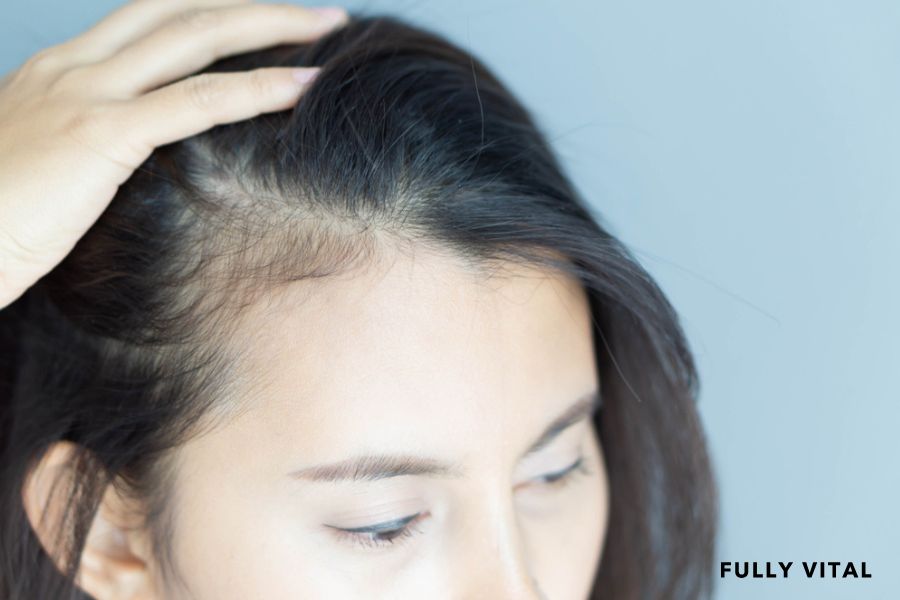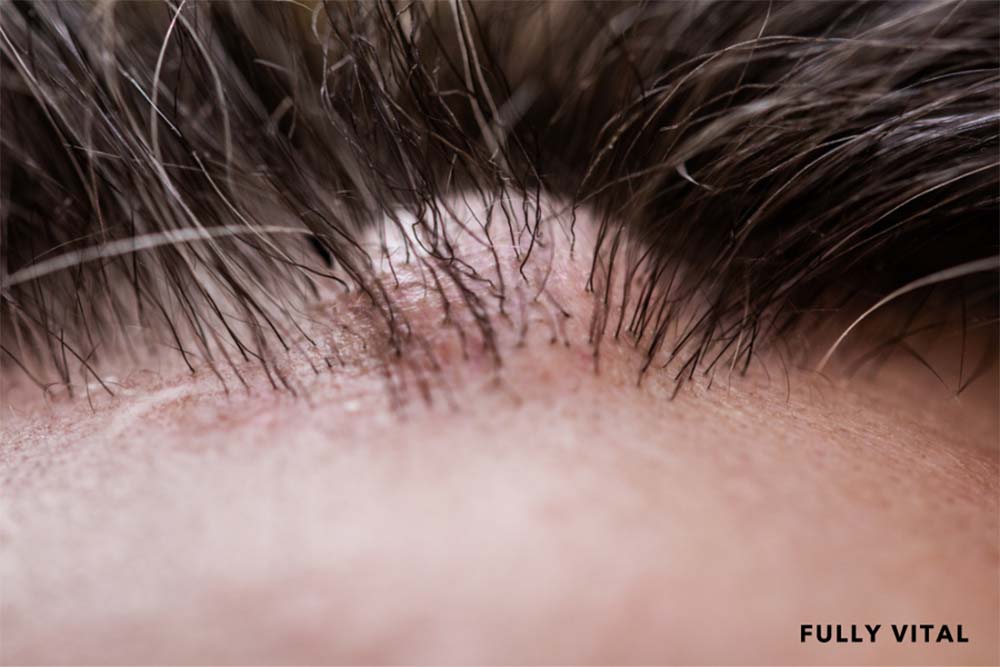
Understanding Receding Hairlines: A Comprehensive Guide
Welcome to our in-depth guide on receding hairlines, an issue that can affect people of all hair types, especially women.
In this article, we will explore various aspects of receding hairlines, shedding light on why understanding them is crucial.
We'll discuss how receding hairlines occur, their benefits when addressed, potential downsides, and alternative treatments.
Our goal is to provide valuable insights for women seeking to stimulate hair growth naturally.
So, let's dive into this conversational journey.

I LOVE MY HAIR NOW
FullyVital hair serum and hair vitamins made tremendous improvements in my hair. I truly love my hair now.
Dorit S.,
What Is A Receding Hairline?
A receding hairline is a term used to describe the gradual thinning and recession of hair from the forehead.
It's often characterized by a receding "M" or "V" shape at the front of the scalp.
This common hair issue can be distressing, but understanding it is the first step towards finding solutions.

Why Is Understanding Receding Hairlines Important?
Why should you care about receding hairlines? Knowledge is power, and understanding receding hairlines empowers you to make informed decisions about your hair care.
It allows you to take proactive steps to address the issue effectively and regain your hair's vitality.
How Does Receding Hairline Occur?
Receding hairlines can occur due to various factors, including genetics, hormonal changes, aging, and lifestyle choices.
These factors can lead to the gradual weakening of hair follicles, resulting in hair thinning and recession.
To combat this, it's essential to know the root causes.1
What Are The Benefits Of Addressing Receding Hairlines?
Addressing receding hairlines offers numerous benefits.
It can boost your confidence, enhance your appearance, and improve overall hair health.
By taking action, you can slow down or even reverse the process, allowing your hair to grow back with vigor.
What Are The Downsides Of Receding Hairlines?
While understanding the downsides of receding hairlines can be disheartening, it's essential to be realistic.
Untreated receding hairlines can lead to further hair loss and reduced self-esteem.
Acknowledging these potential drawbacks motivates you to seek effective solutions.
What Are The Alternatives To Receding Hairline Treatment?
Thankfully, there are alternatives to address receding hairlines.
From hair growth products to lifestyle changes and medical treatments, you have options to choose from.
Discovering these alternatives can help you find the most suitable approach for your unique needs.
What Causes A Receding Hairline?
A receding hairline occurs due to various factors, and understanding its causes is essential for effective management.
Let's delve into the primary contributors to this common hair issue:
Genetics:
- Heredity plays a significant role: If you have a family history of receding hairlines, you may be genetically predisposed to it.
- Androgenetic alopecia: This hereditary condition, also known as male or female pattern baldness, is a leading cause of receding hairlines.
Hormonal Changes
- Fluctuations in hormones: Changes in hormone levels, such as during pregnancy, menopause, or thyroid disorders, can trigger hairline recession.
Aging
- Natural aging process: As we age, our hair follicles may become more susceptible to thinning and recession.
Lifestyle Factors
- Excessive styling: Frequent use of tight hairstyles or heat styling tools can weaken hair follicles.
- Stress: High levels of stress can contribute to hair loss, including receding hairlines.
- Poor nutrition: A diet lacking essential nutrients can affect hair health.
What Are The Signs Of A Receding Hairline?
Identifying the signs of a receding hairline early on can help you take proactive steps to address the issue.
Look out for these telltale indicators:
- Widening Forehead: Your hairline may start to move backward, creating a more prominent forehead.
- Thinning Hair: Noticeable thinning of hair in the front and temple areas.
- Receding "M" or "V" Shape: The hairline may take on an "M" or "V" shape as it recedes.
Can A Receding Hairline Grow Back?
The potential for regrowth depends on various factors, including the underlying cause and the actions you take.
Here's what you need to know:
- Genetics: If genetics are the primary cause, regrowth may be limited, but slowing further recession is possible.2
- Hormonal Factors: Hormonal imbalances can sometimes be corrected, leading to regrowth.
- Lifestyle Changes: Adopting a healthy lifestyle and using appropriate hair growth products can promote regrowth.
Can You Fix A Receding Hairline?
Yes, you can take steps to address a receding hairline and improve its appearance.
Here are some options to consider:
Topical Treatments
Over-the-counter or prescription topical treatments like minoxidil can help stimulate hair growth.
Oral Medications
Some medications, such as finasteride, may be prescribed to combat hair loss.
Hair Growth Products
Explore hair growth shampoos, conditioners, and serums designed to strengthen hair and promote regrowth.
Hair Transplant Surgery
In severe cases, hair transplant surgery can restore a natural hairline.
Lifestyle Changes
Maintain a healthy diet, manage stress, and avoid hairstyles that stress the hair.
How Long Does A Receding Hairline Last?
The duration of a receding hairline varies from person to person and depends on several factors:
- Cause: If the cause is genetic, the hairline may continue to recede gradually over time.
- Treatment: With appropriate treatment and care, you can slow down or even reverse the process.
- Maintenance: Continuous maintenance and lifestyle adjustments may be necessary to maintain results.
What Is The History Of Receding Hairlines?
- Ancient beliefs and remedies: Throughout history, various cultures have held beliefs and concocted remedies to combat hair loss, recognizing the emotional and societal significance of hair.
- The evolution of treatments: Over the years, treatments for hair loss have evolved from herbal remedies to modern medical and cosmetic solutions.
- Scientific advancements: Recent years have seen significant advancements in understanding the underlying causes of receding hairlines, leading to more targeted treatment approaches.
What Is The Current Environment Of Receding Hairlines?
- Prevalence: In today's fast-paced world, receding hairlines are still a common concern, affecting individuals of all genders, ages, and backgrounds.
- Innovation in products: Hair growth product companies continually innovate to meet the growing demand for effective solutions, offering a wide range of products catering to different needs.
- Holistic approach: The current approach to addressing receding hairlines goes beyond topical treatments, emphasizing lifestyle changes, stress management, and overall well-being.
What Is The Future Of Receding Hairlines?
- Advancements in regenerative medicine: Ongoing research in regenerative medicine and stem cell therapy holds promise for revolutionary treatments that may provide lasting solutions to receding hairlines.3
- Personalized solutions: With advances in genetics and personalized medicine, future treatments may become increasingly tailored to an individual's genetic predisposition and specific needs.
- Enhanced product efficacy: Hair growth product companies are likely to continue improving product formulations and delivery methods, enhancing their effectiveness and user experience.
Unlock The Secret To Youthful Hair With Fully VitalDiscover the key to unlocking your hair's full potential with Fully Vital's powerful, science-backed hair growth products. Our mission is clear: to help you slow down and reverse the aging of your hair so that you can enjoy a healthier, more vibrant relationship with your locks.
Revitalize your hair, restore your confidence, and embrace a more youthful you with Fully Vital. |
Final Thoughts On Receding Hairlines
Understanding receding hairlines is not just about addressing a common hair concern; it's about empowering individuals to take control of their hair health and embrace a more confident self.
At Fully Vital, we are committed to providing you with the knowledge and solutions you need to combat receding hairlines and nurture a healthier relationship with your locks.
Our wide range of hair growth products is designed to stop the aging of your hair and promote its vitality.
Whether you're looking for topical treatments, holistic approaches, or personalized solutions, we have the products to meet your unique needs.
Don't let a receding hairline hold you back.
Take proactive steps today to maintain and restore the beauty of your hair.
Your journey to healthier, more vibrant locks starts with understanding, and Fully Vital is here to support you every step of the way.
Frequently Asked Questions About Receding Hairlines
Can receding hairlines be prevented?
While genetics play a significant role, you can take steps to prevent or slow down receding hairlines.
Maintain a healthy lifestyle, use hair growth products, and consult with a healthcare professional for personalized advice.
Are there natural remedies for addressing receding hairlines?
Yes, there are natural remedies like scalp massages, essential oils, and dietary changes that can promote hair growth and strengthen hair follicles.
What is the role of diet in preventing receding hairlines?
A balanced diet rich in essential nutrients, such as vitamins, minerals, and proteins, plays a crucial role in maintaining healthy hair.
Nutrient deficiencies can contribute to hair loss.
How long does it take to see results from receding hairline treatments?
Results can vary from person to person, but with consistent treatment and care, you may start noticing improvements in a few months.
Are there any side effects associated with receding hairline treatments?
Some treatments may have minor side effects, such as scalp irritation or dryness.
It's essential to follow product instructions and consult with a healthcare professional if you experience any adverse reactions.
Can stress worsen receding hairlines?
Stress can indeed exacerbate hair loss and receding hairlines.
Practicing stress-reduction techniques like meditation and yoga can be beneficial.
When should I seek professional help for my receding hairline?
If your receding hairline is causing significant distress or doesn't improve with at-home treatments, consider consulting a dermatologist or trichologist for expert guidance.
Are there support groups or communities for people dealing with receding hairlines?
Online communities exist.
Many online forums and support groups provide a platform for individuals experiencing hair loss and receding hairlines to connect, share experiences, and seek advice.
These communities can offer emotional support and practical tips.
Can receding hairlines be a sign of a more serious medical condition?
Possibly, but it's not always the case.
While receding hairlines are often benign, they can sometimes be a symptom of an underlying medical condition, such as thyroid disorders or autoimmune diseases.
If you're concerned, consult a healthcare professional for a thorough evaluation.
How can I find the right hair growth products for my receding hairline?
Consult with a professional.
Seek guidance from a dermatologist or hair care specialist to determine the most suitable hair growth products for your specific needs.
They can recommend products based on your hair type, the cause of hairline recession, and other factors.
Sources:
- Harvard Health Publishing. (2018, December 5). Hair Loss - Harvard Health. Harvard Health; Harvard Health. https://www.health.harvard.edu/a_to_z/hair-loss-a-to-z
- Hernandez, L. M., & Blazer, D. G. (2016). Genetics and Health. Nih.gov; National Academies Press (US). https://www.ncbi.nlm.nih.gov/books/NBK19932/
- Shimizu, Y., Ntege, E. H., Sunami, H., & Inoue, Y. (2022). Regenerative medicine strategies for hair growth and regeneration: A narrative review of literature. Regenerative Therapy, 21, 527–539. https://doi.org/10.1016/j.reth.2022.10.005







